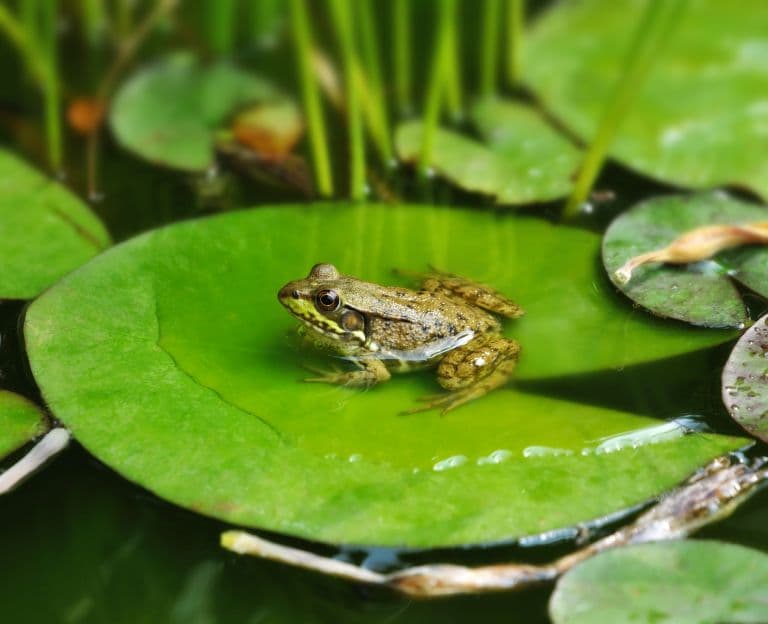When you see a familiar little amphibian hopping about in the grass, it can be tricky to know for sure whether you’re looking at a frog or a toad. Even seasoned animal lovers get stumped by this question, and for good reason.
There’s a mix of rules and generalisations to tell them apart and a whole bunch of exceptions, so the most common (and likely easiest) way to tell them apart is by using the age-old wisdom from Neature Walk, “You can tell it by the way that it is”.
There is, fortunately, one strict definition of a toad, and we’re going to look at that first, followed by a bunch of other generalised differences, in case simply looking at it isn’t enough of a clue.

Let’s find out the differences between frogs and toads.
1. They’re both Anurans
There’s not a huge taxonomic difference between what are commonly called frogs and what are commonly called toads.
Anurans are the order of amphibians that make up both. These animals are thought to have branched off from other amphibians remarkably far back into the past, in the Permian.
This period predates the dinosaur dominance over the land and was home to some pretty epic creatures like Dimetrodon and Diplocalus. At around this time, the animals that would become frogs and toads separated from the ones that would eventually become salamanders and newts.
This frog and toad group became the order Aura, and within it, there are over 55 families. Only one of these families, the Bufonids, are what are known as the true toads, so from a classification perspective, frogs are any family in that order, and toads are the family of frogs known as Bufonids.
But there are a bunch of other frog species commonly called toads, so if we relax the strict definition a little, what differentiates them from frogs?
2. Frogs are generally wetter
One of the characteristics of frogs that separates them from toads is how damp they are. In general, frogs are very dependent on water, and can’t venture far from it at all. They have exceedingly wet skin and are susceptible to dehydration a lot more than toads are.
Conversely, a toad’s skin is typically drier and wartier, and this lets them embark on slightly longer journeys away from their watery home. As amphibians, they still rely on water for their reproduction, but they’re generally less bound to between these cycles.
The frog’s wet skin is covered in a thin layer of mucous but it’s permeable and extremely sensitive. As such, frogs are some of the most vulnerable animals to environmental changes, often the first to die out when toxins enter the water systems. 1

3. Toads lay egg strings
On the topic of eggs, everyone who’s ever spent time around ponds in the Spring knows the familiar clumps of dotted jelly balls that come out the back end of a gravid anuran during the breeding season.
These, too, can indicate whether that back end belonged to a frog or a toad. Frogs make the recognisable clumps, and toads tend toward longer strings of eggs, forming floating strands.
Both are similar in that they have the little black tadpole yolk in there, and they’re surrounded by protective jelly, but the shape is distinctly different for toads. 2
4. Many toads have a unique organ
If you want to get up close and personal and you’re looking at the internal makeup of your anuran, you might find a spherical, brownish organ just in front of the kidney. If you do, you can be sure you’re looking at a toad.
Only members of the Bufonidae family have this organ, known as a Bidder’s organ. The nature of its true function is a bit muddy still, but it relates to reproduction and maybe some kind of rudimentary oocyte production facility.
Regardless of what it actually does, if you find one, you’re definitely looking at a toad. But if you don’t, you still can’t be sure, because not all toads have them!
So, what else can you look for? 3

5. Frogs are generally more agile
By the time you’re dissecting its organs, it’s probably too late to assess this, but let’s say you haven’t opened it up yet and it’s still very much alive.
Frogs have very long legs, often longer than their head and body. These glorious pins are made for hopping, swimming, and generally behaving very athletically, at least compared toads.
Toads have much shorter legs and prefer to crawl around rather than hop, so if it’s ambling around, it’s more likely to be a toad.
6. All toads are toxic
If all else fails, you could try licking it. This is essentially as dangerous as trying to identify a mushroom by eating it, so proceed at your own risk.
All toads are toxic. But herein lies another complication that we’ve come to expect from frogs and toads: a whole bunch of frogs are toxic, too.
So basically, if you lick it and you’re fine, it’s a frog. But if you lick it and die, or start seeing things that aren’t there, it could be either. 4
Final Thoughts
So there you have it – frogs versus toads!
So, there are a bunch of general rules for telling frogs from toads. Toads are generally lumbering, dry-skinned, toxic Bufonids with a Bidder’s organ. But not all behave this way, and there are quite a few frogs that behave similarly.
The strictest definition is the taxonomic one, but this leaves out all the toad-like frogs and becomes a bit arbitrary in the majority of non-scientific cases.
Essentially, all toads are a family of frogs, as related to the other families as any other. So, if you want to play it safe, you can rely on the fact that toad or not, it’s still a frog.
Fact Sources & References
- https://www.irishtimes.com/news/environment/is-it-okay-to-touch-a-frog-or-will-we-burn-its-skin-readers-nature-queries-1.3175875
- https://www.rekoforest.org/field-stories/six-key-differences-between-frogs-and-toads/
- https://pubmed.ncbi.nlm.nih.gov/26154323/
- https://www.vetlexicon.com/canis/internal-medicine/articles/toad-poisoning/
